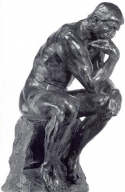Philosophy
Consciousness is so complex partly because it is closely connected to the mystery of existence. Our sensorial experience of reality is different from our understanding of it by measurement and analysis. This difference is already clear when we look through a magnifying glass or binoculars. The measurements and their analysis through mathematical processes are used to create a model, for example that of an atom or of space-time. Such a model is nested in the global model of the world around us that is automatically constructed by the perceptual processes in our brain. In other words, our scientific models obtain information from internal representations of reality. The latter we experience not as a model but intuitively as reality itself. Other nested models include those of our social perceptions.
The particular perspectives and the scales, at which we zoom in or out, are a continuously changing reference. From each of these levels (of scale or 3D) we have a different glimpse at reality. The currently observed reality contains also the reference point from which we see her. For this reason, there is no such thing as pure reality (which I have called cruality or, more correct, extraversum) that can be perceived. The aspect of the extraversum that is observed and the observing body - being itself an aspect of reality, namely an organic cluster (like a human being), capable of cognition (awareness) - form an indivisible whole. Thus, the known always contains the knower. The observed is fused with the footprint of the observer, like we cannot watch a mirror without seeing ourselves. This phenomenon includes observations in a tight academic setting. Intersubjective agreement allows objective phenomena and principles to be isolated, but objectivity is partly reflected in the uniformity of how brains represent aspects of reality. The neural principle according to which the sensory input is organized and represented in the introversum of an individual is roughly equal to all people. All this may give us a clue about the consciousness phenomenon.
In my view, to understand what consciousness is, we should explore the relationship between first person phenomenological and third person scientific representations of reality. For both our subjective perception as our scientific and mathematical models are based on perceptual categories. Perceptual experience is a fundamental bottleneck only after which differentiation occurs between real time perceptual experience on the one hand, and memory traces leading to the formation of language and abstract (also scientific) concepts on the other hand. These are mutually associated, by which we constantly construct and update our representation of reality. What happens before the bottleneck seems even unknowable, comparable with our ignorance of what could have happened before the Big Bang. We are bound to the concepts within our introversum in order to explain and understand aspects of reality and their interactions. Our conceptual memory is the reference, a relatively fixed point, to which we evaluate the spatial and temporal relationships outside ourselves.
Speaking about extraversum, cruality or 'res extensa' will automatically trigger our imagination, a tendency not easy to suppress. Each imagined interpretation is based on perceptual concepts inside the bottle (see my earlier metaphor about the bottleneck). One of the reasons high functioning autistics are so good at math may be their lack of imagination and might therefore not so easily be distracted by that. But both imagination and mathematical analysis are products of brain activity. Both are approximations of reality through abstract concepts that presuppose (the bottleneck of) consciousness. If we want to understand what consciousness is, then what will be the lacking chain that finally elicits an eureka? What then do we know? The answers will certainly not substitute for awareness itself, like understanding and knowing everything about your dog cannot substitute for your dog itself. Knowledge and understanding include increased relations between the nested representations discussed before.
The cruality of atoms, energy, explosions, vast emptiness and never-ending time is something of a cold, impersonal, overwhelming and even frightening data, compared to which our social life on earth seems a warm and safe haven. That is the way an astronaut must feel when returning to earth after a space mission. Our life on earth, rather, our introverse representing a shared biosphere, seems a strange, lost diamond, the 'pale blue dot' in a vast emptiness of primal forces. This view primarily reflects ignorance of course. We know relatively much more about what is nearby than far away. It has always been like that, and since our scientific conquests not that much has changed. There may be ignorance because we define everything 'out there' in terms of particles and energies, in itself impersonal, operational concepts. Religions have always been more connected to the personal interpretation and reference frames of our small introverses. That is why they still have much appeal for most people. But both our cold scientific concepts and the religious fairytale language are ultimately models that represent something we cannot directly know.*) At the same time, they are stories, myths if you want, to which we feel more or less attracted. Science and religion, extraversum and afterlife, are references to the reality 'out there', which at its very best we are able to test for internal consistency. With regard to the latter, science is the winner if you take evidence as a criterion and can accept that truth and desirability (the wish it to be true) are not the same.
*) The same is true for our feelings that, even when suggesting deep significance, have their domain in our private universe.

